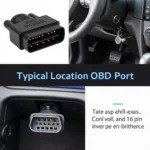OBD2 Load PCT, or engine load percentage, is a crucial parameter monitored by your vehicle’s onboard computer. This metric provides valuable insights into your engine’s performance and can be instrumental in diagnosing potential issues. Whether you’re a car enthusiast or a professional mechanic, understanding OBD2 Load PCT is essential.
What is OBD2 Load PCT?
In simple terms, OBD2 Load PCT represents the percentage of the engine’s maximum air intake capacity being used at any given moment. It essentially indicates how hard your engine is working. A higher load percentage means your engine is working closer to its full potential, while a lower percentage signifies a lighter workload.
How is Load PCT Calculated?
The calculation of Load PCT involves various factors, including:
- Mass Air Flow (MAF) Sensor Readings: This sensor measures the amount of air entering the engine.
- Manifold Absolute Pressure (MAP) Sensor Readings: This sensor measures the pressure inside the intake manifold.
- Engine Speed (RPM): The rotational speed of the crankshaft.
- Air Intake Temperature: The temperature of the air entering the engine.
The engine control unit (ECU) uses a complex algorithm incorporating these readings to determine the Load PCT.
Why is OBD2 Load PCT Important?
Monitoring Load PCT can provide valuable insights into your vehicle’s health and performance. Here’s why it matters:
- Diagnosing Engine Problems: Unusual Load PCT readings can be early indicators of engine problems, such as a clogged air filter, faulty MAF sensor, vacuum leaks, or issues with fuel delivery.
- Optimizing Fuel Economy: By understanding how Load PCT correlates with driving habits, you can adjust your driving style to improve fuel efficiency. For example, accelerating gradually typically results in lower Load PCT and better fuel economy.
- Enhancing Performance: For performance enthusiasts, Load PCT can be used to gauge how effectively modifications are impacting engine output.
Common OBD2 Load PCT Values and Their Meanings
While Load PCT values can vary depending on the vehicle and driving conditions, here are some general guidelines:
- Idle: At idle, Load PCT is typically in the range of 3-10%.
- Cruising: During steady cruising speeds, Load PCT will generally fall between 15-30%.
- Acceleration: When accelerating, Load PCT will increase significantly, potentially reaching 80-100% under heavy acceleration.
- Deceleration: When decelerating or coasting, Load PCT will drop, often nearing 0%.
Troubleshooting High Load PCT
Consistently high Load PCT, even under normal driving conditions, could indicate a problem. Here are some potential causes:
- Clogged Air Filter: A restricted airflow due to a dirty air filter forces the engine to work harder, leading to elevated Load PCT.
- Faulty MAF Sensor: An inaccurate MAF sensor reading can mislead the ECU into providing an incorrect air-fuel mixture, resulting in high Load PCT.
- Vacuum Leaks: Leaks in the intake manifold or vacuum hoses can disrupt airflow measurements and cause the ECU to overcompensate, leading to increased Load PCT.
 Mechanic Inspecting Engine Bay for Load PCT Issues
Mechanic Inspecting Engine Bay for Load PCT Issues
Troubleshooting Low Load PCT
While less common, consistently low Load PCT can also signal underlying issues:
- Faulty MAP Sensor: An inaccurate MAP sensor reading can lead to an overly lean air-fuel mixture, resulting in decreased engine load.
- Exhaust System Restrictions: A clogged catalytic converter or muffler can create backpressure in the exhaust system, hindering engine performance and leading to lower Load PCT.
- Fuel Delivery Problems: Issues with the fuel pump, fuel filter, or fuel injectors can restrict fuel supply, causing a drop in engine load.
OBD2 Load PCT: A Powerful Diagnostic Tool
Understanding and monitoring OBD2 Load PCT is crucial for maintaining your vehicle’s health, optimizing fuel economy, and diagnosing potential engine problems. By utilizing an OBD2 scanner and interpreting Load PCT readings, you can gain valuable insights into your engine’s performance and ensure smoother, more efficient operation.
“Monitoring Load PCT is like having a finger on the pulse of your engine. It allows you to detect subtle changes in performance that might otherwise go unnoticed,” says automotive expert John Smith.
Remember, if you encounter persistent unusual Load PCT readings, it’s crucial to consult a qualified mechanic for a thorough diagnosis and repair.
Frequently Asked Questions about OBD2 Load PCT
1. Can I use OBD2 Load PCT to diagnose transmission problems?
While Load PCT primarily reflects engine load, it can indirectly provide clues about transmission issues. For example, if you notice unusually high Load PCT when shifting gears, it could suggest a slipping transmission.
2. Is a higher Load PCT always bad?
No, a higher Load PCT is expected during acceleration or when driving uphill. However, consistently high Load PCT under normal driving conditions might indicate an underlying problem.
3. What are some common symptoms of a faulty MAF sensor?
Symptoms of a faulty MAF sensor can include rough idling, poor acceleration, reduced fuel economy, and the check engine light illuminating.
4. Can I clean a clogged air filter, or do I need to replace it?
While cleaning a mildly dirty air filter can provide temporary improvement, it’s generally recommended to replace it with a new one for optimal performance.
5. What should I do if my Load PCT readings are outside the normal range?
If you consistently observe Load PCT readings that are significantly higher or lower than expected, it’s advisable to consult a qualified mechanic for a proper diagnosis.
For further insights into related OBD2 parameters and their significance, explore our articles on tac_pct obd2 and tac pct obd2. Understanding these parameters can provide a more comprehensive view of your engine’s performance.
If you have any further questions or need expert advice on OBD2 diagnostics, don’t hesitate to contact our team via WhatsApp at +1(641)206-8880 or email us at [email protected]. Our dedicated customer support team is available 24/7 to assist you.

